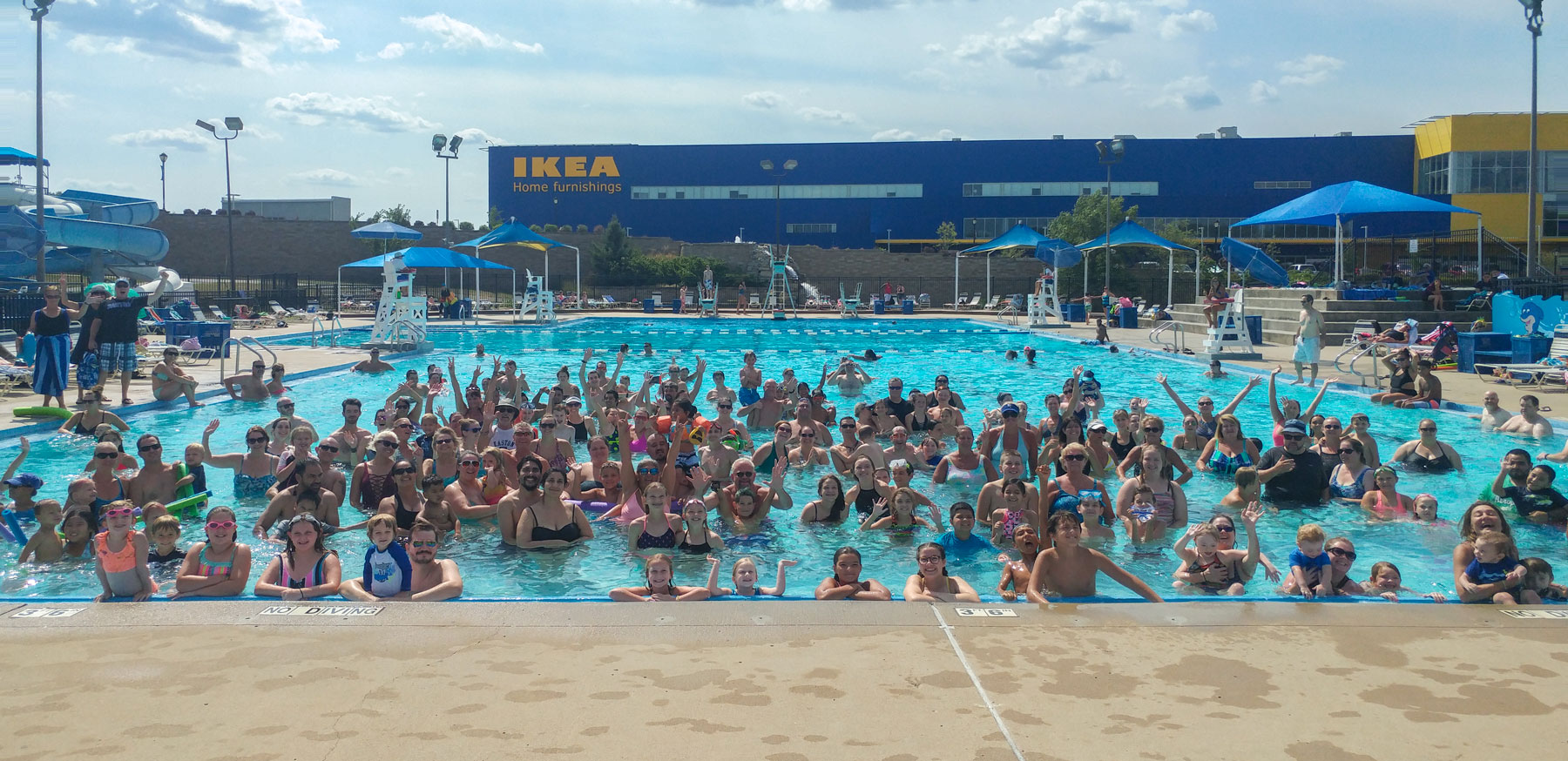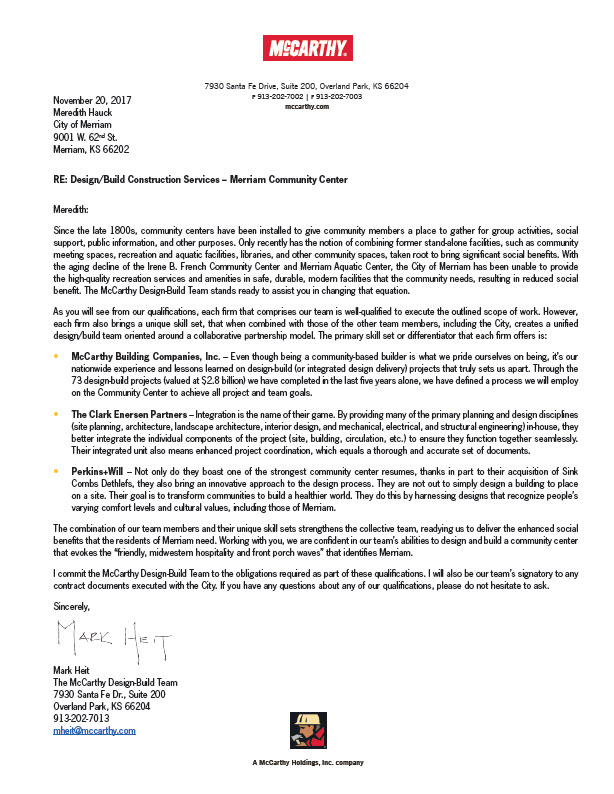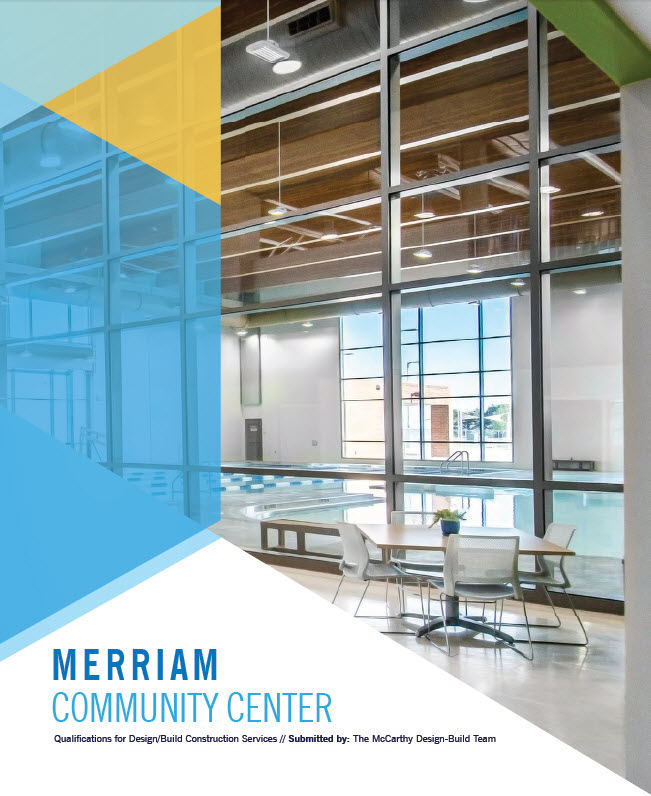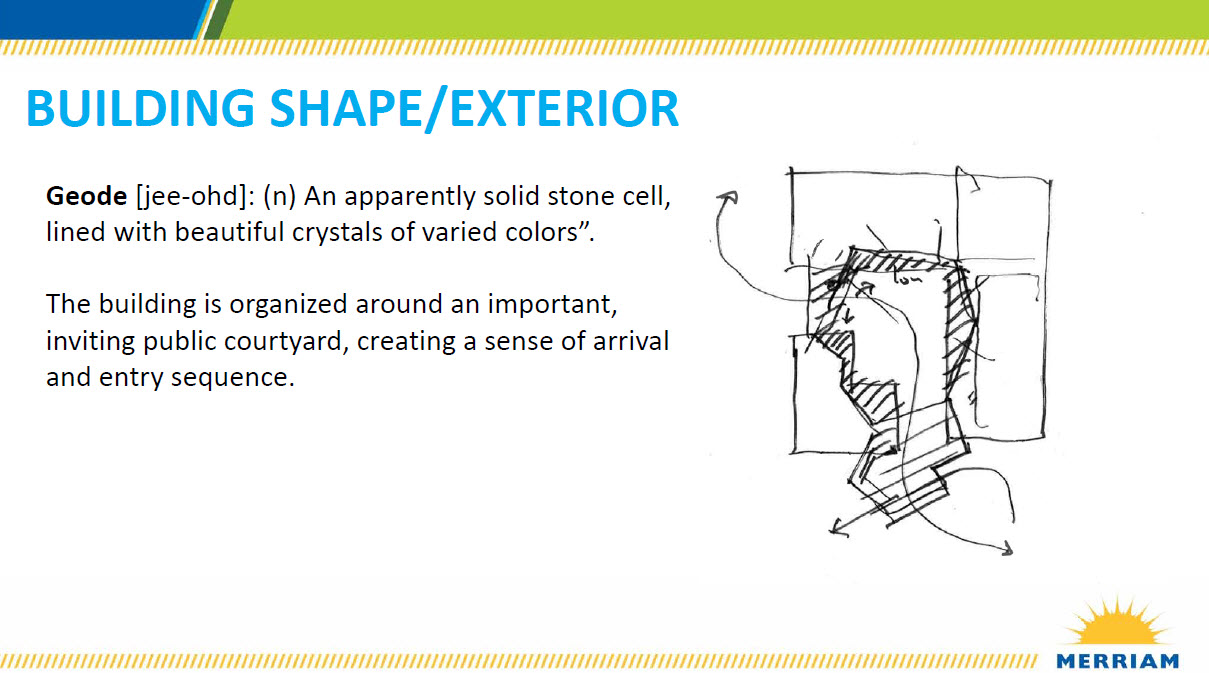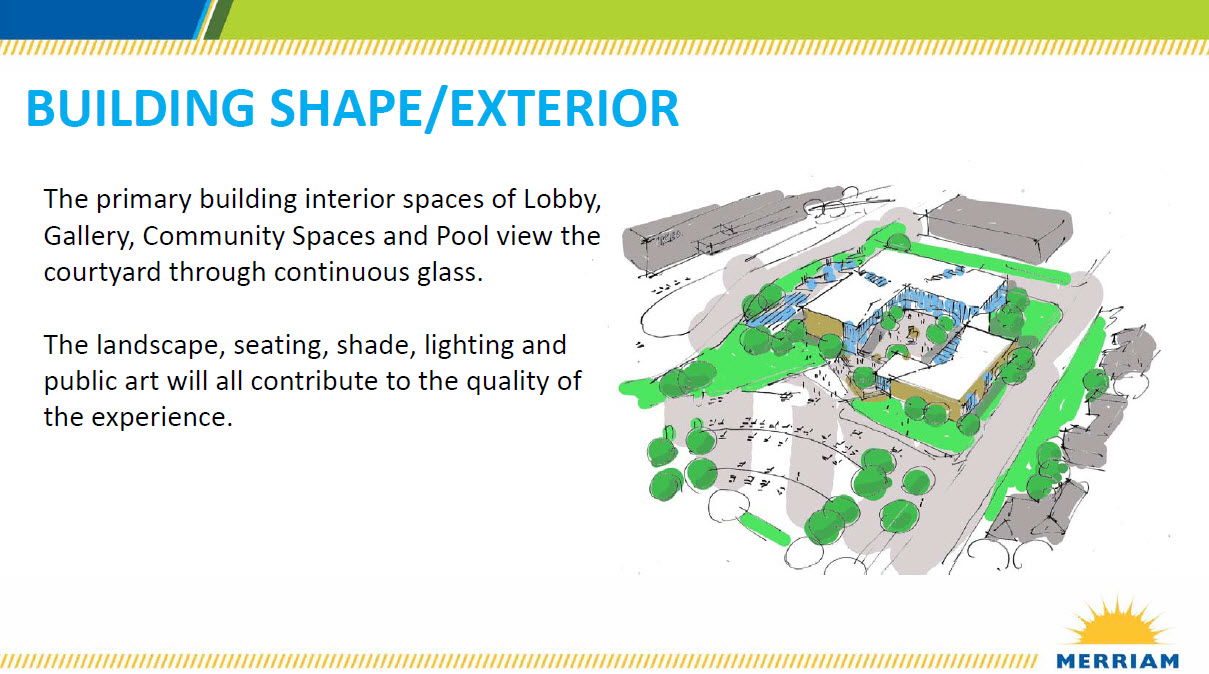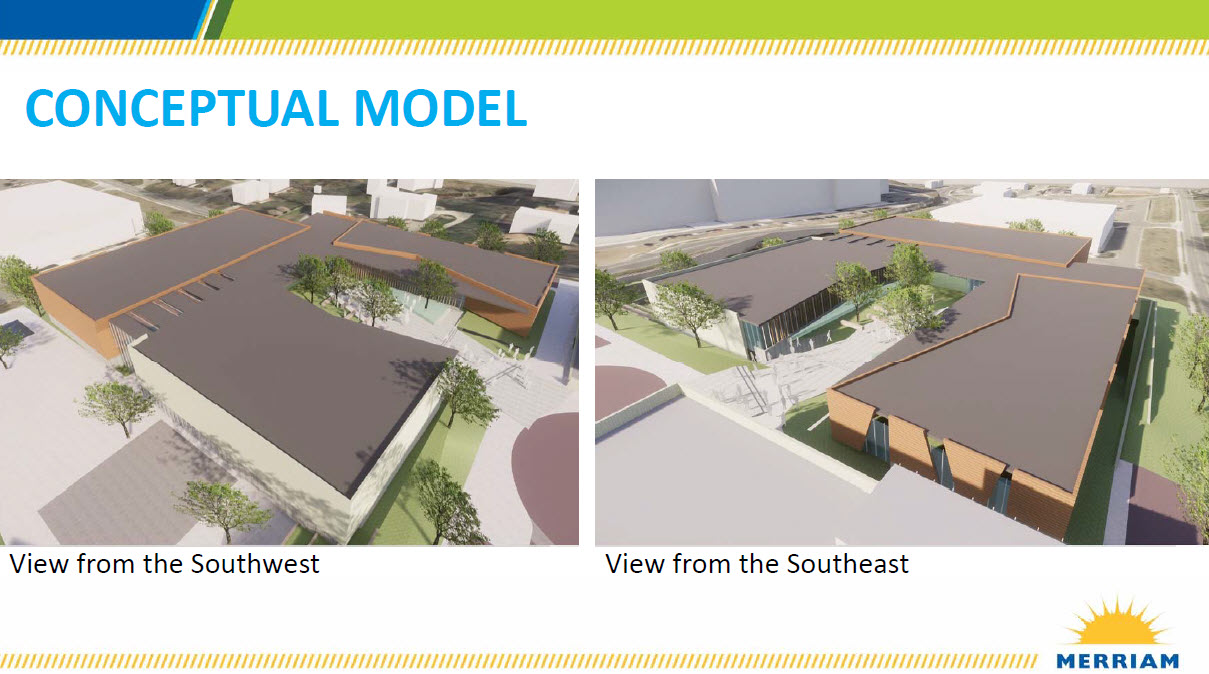Issues In Review/Before the City Council
New Merriam Community Center Design
Design Process Audit
by David Neal, Merriam City Council
August 14, 2018
Last Updated September 15, 2018
As a member of the City Council, I believe it is one of the duties of all elected officials to provide oversight and thoughtful judgment concerning activities that the City is undertaking. When something doesn't seem right, as an elected official you should ask questions and try to understand to the best of your ability any discrepancies between the information that has raised your concerns and any other factual information you can develop. The purpose of this series of posts is to discuss issues that have been raised about the new Merriam Community Center and Aquatics Center project.
Disclaimer: Within this post are images I have adapted to demonstrate ideas that I am attempting to communicate to the public. Some of these images have been derived from other images that have been presented to the public as part of the Merriam Community Center design process and may appear to have been documents produced as part of the City's design process. Rather then being official city documents, they were produced using available software tools as derivations from original documents. They are included as part of the discussion since I did not have direct participation in the City's design process that produced the original documents, I did not have access to the design software used, or to the outside design consultants directly. I was forced to use the public documents and add overlays or other modification for illustrative purposes as part of my discussion with the public. Despite the possible presence of company logos on some derived images, these adaptations were prepared by me alone.
Overview: Design-Build Process - Too few safeguards used in the Merriam process
Based on my engineering and construction background, I have carefully reviewed the master plan and supporting documents for the new Merriam Community Center. I have reviewed the work of the various committees involved in the selection of the design-build contractor and in the design review process for what amounts to a no-bid design and construction project. As a result, I have discovered and compiled detailed information in this report that appears to show that during the City's implementation of the "design-build" process:
- The selection of the design-build contractor team was made by an appointed group of individuals collectively lacking adequate knowledge/experience in technical aspects of major construction projects to evaluate the suitability of competing teams from a technical and experience fit perspective with this project.
- The Design-Build Selection Committee was overweighted with staff individuals that have a direct chain of command reporting structure to the Mayor.
- One of the other two non-staff (and consultant) individuals on the Design-Build Selection Committee seem to have had a conflict of interest because of key decision making roles with both the Johnson County Library and with the City of Merriam. Decisions related to an emerging partnership between the two entities necessarily have trade-offs meaning such an individual with dual loyalties cannot reasonably be expected to make a decision affecting one party without impacting the other party.
- The Design-Build selection process was truncated and did not perform the second phase of what is recommended to be a two phase selection process.
- The lead architecture and engineering (A&E) firm and the A&E project manager selected for the Merriam Community Center project have a long track record designing library buildings for Johnson County and other jurisdictions, but no significant record designing community centers with aquatics.
- The selection process for the Community Center Design Committee which appears to have been a collaboration between the Director of Parks and the Mayor, did not result in even one member selected from the Merriam aquatics patrons community, despite the fact that the 2017 Facilities Master Plan included approximately 1/3 of the new community center project budget earmarked for aquatics.
- After selection of the design-build team, the announced early phases of design also appear to have been truncated in terms of considering multiple concept designs. If more than one concept design was considered (I have been asking what other concept designs were prepared and have not yet received an answer), alternatives were not shared beyond the city staff project team. Alternative concept designs were not shown to the Community Center Design Committee, the Parks Board, the Community Center Steering Committee, or the City Council.
- The Community Center Design Committee never met during the first 4-5 months of design work. Staff made all the early critical decisions with out any broader feedback from Merriam's stakeholders.
- The library interests seem to have been much more closely involved in design during these critical months than the new Merriam Community Center's interested parties.
- The first Design Committee meeting on June 6, 2018 dealt with presenting an already-decided "geode" building design concept in a highly developed site plan and building design. This pattern of presenting completed design decisions removed any chance of a meaningful feedback mechanism.
- The June 6, 2018 meeting was also significantly devoted to discussion the requirements and design implications of co-locating the library on the community center campus. No discussion of aquatics was even thought to be important to consider even though the staff-decided design decisions forced serious constraints on the aquatics design.
In summary, major elements of a competent design-build process were not completed for the new Merriam Community Center in the early stages. The design direction and the promises made to Merriam residents as reflected in the 2017 Facilities Master Plan appear to have been very poorly followed by the feedback-deficient internal staff design process. Outdoor aquatics has been significantly downgraded in the design for the new community center as a result.
Process breakdowns have resulted in a design featuring a costly entry courtyard and a constrained outdoor aquatics area leading to an inflated project cost that can't fit the features detailed in the Master Plan into the original $30 million project budget. At a current project budget of $36.6 million, Merriam is still getting less than expected for more money. Therefore, the current project design should be reviewed/audited thoroughly before demolition of existing facilities or construction of the new community center proceeds.
Design-Build process not a good fit for Merriam staff skills
The design-build process was selected as the approach that Merriam city staff wanted to use in this major project for the city. That decision had already been made before I took my seat on the City Council in January 2018.
In addition, an ad-hoc committee was appointed in late 2017 by the mayor to recommend which design-build team the City of Merriam should hire for the new community center project.
The Mayor-appointed Design-Build Selection Committee consisted of:
- (Merriam City Staff) City Administrator, Chris Engel;
- (Merriam City Staff) Parks and Recreation Director, Anna Slocum;
- (Merriam City Staff) Assistant City Administrator Meredith Hauck;
- (Merriam resident) Park Board/Community Center Steering Committee representative Thelma Fowler;
- (Chair of Johnson County Library Board and Merriam City Council Member) City Council/Library Board Representative, Nancy Hupp, and
- (City Contractor reporting to City Staff) Owner's Representative Michelle Kaiser
There does not appear to have been a formal process for filling this important selection committee, nor approval by the City Council. A review of the minutes of Council Meetings prior to my service on the City Council (I had attended all relevant meetings as a citizen audience member at that time) does not indicate how the Design-Build Selection Committee was chosen or whether such selection was approved by the City Council or even discussed with the Governing Body.
No member seems to have had any relevant construction, architecture, or engineering background which would seem helpful in making critical distinctions in evaluating the qualifications of the design-build firms that applied for consideration.
Ultimately the Design-Build team selected was one headed by the Mayor's nephew. This information was disclosed to the City Council four days before the vote to approve the team. City staff assured the Council that the selection process was conducted fairly and nobody involved with the selection process was aware of the family connection when evaluating the applicants.
Design-Build versus Design-Bid-Build processes
While the 'design-build' process is favored by many large builders, it is considered by others to be a process that favors primarily the designers and builders rather than the owners of the project.
Some of these concerns are explained in a 2005 article available from the American Bar Association entitled, "Perplexing Issues in Design-Build Projects." The authors caution that it is critical for a project owner like Merriam to really understand the design-build issues very well before entering into such an arrangement:
"Contract negotiation affects project success and is essential because the American Institute of Architects (AIA) and Associated General Contractors of America (AGC) standard contracts are designed to protect design-build entities."
The selection of the design-build team is critical. Typically the selection process follows a two phase approach:
"If the owner wants competition or varying ideas, the owner should solicit proposals from multiple firms.
Typical design-build competitions are done in two phases. Phase I is generally a paper submission of basic information, such as
- identity of the team participants and key staff members,
- firm background information,
- representative design-build projects, and
- broad ideas about the project that illustrate an understanding of the owner’s needs.
If the request for proposals receives significant response, the field for Phase II is narrowed to five or fewer entities. If only a few proposals are received, all will likely participate in Phase II. And, if only a few were solicited in the first place, the owner may request all the information at once.
Phase II consists of meeting with the owner to get as much information as possible about the project. Then the team members go to work by
- identifying a design concept,
- fleshing out the design in terms of schematic drawings, so that cost estimates and a constructability analysis can be performed,
- retaining sub-consultants and identifying subcontractors for problematic aspects of the work and negotiating terms for their participation,
- compiling cost estimates based on material selections and rough drawings,
- preparing sketches, drawings, models, and other presentation materials, and
- participating in presentation meetings.
The amount of time and resources required is great. To increase participation, some owners offer a stipend to Phase II participants. Still, Phase I expenses are not covered, and the stipend is usually only a fraction of Phase II expenses."
Based on my review of the process Merriam undertook to choose its design-build contractor and team, only Phase I was actually completed before a selection was made.
The aforementioned ABA article "Perplexing Issues in Design-Build Projects." ends with some prescient advice:
Conclusion
"The usefulness and practicality of a project’s design, in terms of the owner’s maintenance and other expenses, may be frustrated by design-build. Because the separate entities used in typical design-bid-build projects are part of the same team, an important counterweight for the owner – review of construction by the designer and design by the contractor – is removed. Because the parties share profitability in a design-build project, they lack the incentive to review the other’s assumptions, conclusions, and cost estimates.
A possible solution is hiring an independent owner’s representative or using in-house personnel to review the design before owner acceptance. But the cost of the independent representative may outweigh the benefits of choosing design-build, thus justifying choosing an independent contractor and designer—both of whom would be directly responsible and liable to the owner in the event of problems."
I would concur with the conclusions in the ABA piece. The abilities of the Owner's Representative is key to protecting the interests of the city on this type of project.
Merriam is currently set to pay CBC Real Estate nearly a half million dollars ($476,480) for the work of our Owner's Representative. I am wondering if the City of Merriam is getting its full value from this expenditure as things now stand, given the design process result that the city is currently struggling with.
Before our vote approving the selection recommended by the Design-Build Selection Committee, the City Council was not informed of the list of other teams that made submissions, their RFQ submissions, nor of the reasons they were not selected.
A subsequent public records request by a Merriam resident, then later reviewed by me shows that the following list of teams submitted proposals:
- Crossland Construction / Yaeger Architecture
- JE Dunn Construction / PGAV Architects
- McCarthy Building Companies, Inc. / Clark Enersen Partners
- McCown Gordon / SFS Architecture
- Nabholz / HMN Architects
- Paric / Archimages
- Prosser|Wilbert Construction, Inc, / WNB Architects
- Sampson Construction / Alley Poyner Macchietto Architecture (APMA)
- Straub Construction Co. / DRAW Architecture + Urban Design
- Titan Built, LLC / Hoefer Wysocki Architects, LLC
- Turner Construction / Gould Evans Architects
In hindsight, I wonder why reputable local firms with recent and local community center / aquatics center construction projects were not chosen instead. For example, JE Dunn Construction which just completed the larger Lenexa Community Center in our sister community, but was not selected.
This decision to not choose JE Dunn was made despite also having our own day-to-day Owner's Representative Michelle Kaiser – who was also a member of the Design-Build Selection Committee – also reportedly having just filled the same Owner's Representative role on the Lenexa Community Center project. CBC Real Estate as the Owner's Representative firm for this recent local community center project with aquatics and Michelle Kaiser, personally as the Owner's Representative on the project, must have known JE Dunn's work in this context and visa-versa.
It is logical that JE Dunn would have very current knowledge of current costs for materials and subcontract labor in Johnson County for this type of project as well as knowledge of the specific local challenges in building a community center with aquatics here. I would have liked to have heard more about why JE Dunn and other finalists were not selected.
After the poor design choice for the outdoor aquatics program first recommended by the 'Design Team' on July 9, 2018, I was reminded of my earlier reservations about the selection of the McCarthy team.
While McCarthy is a fine builder as a firm, the team assembled for this particular engagement did not seem to be the best fit for Merriam's needs in my view.
At the time the Design-Build Selection Committee made its recommendation and presented the choice to the City Council, I had been serving on the City Council for only one meeting. Despite this, after receiving my council packet on the Thursday evening before the scheduled Monday City Council meeting on the evening of January 22, 2018, I looked closely at the RFQ information submitted by McCarthy.
I had specifically requested the RFQ be included in the Council Packet earlier on Thursday morning when I and another councilmember were informed by the City Administrator that the overall Project Manager for the selected Design-Build team was actually the Mayor's nephew. I carefully reviewed the 115 pages of RFQ submission from the McCarthy team over the weekend.
That review concerned me greatly.
I then spent more than two hours in the office of the Merriam City Administrator that following Monday morning (Jan 22, 2018) before the Council meeting expressing my reservations with the selection of McCarthy as the builder and Clark Enersen Partners as the lead architect and engineering firm, based on my concerns about the team's lack of experience designing and building community centers with indoor and outdoor aquatics components.
Virtually all the design experience in community centers with aquatics on the team appeared to reside in the third tier of responsibility among the listed team partners. The community center design expertise seemed to all be provided by Perkins+Will, an internationally known firm, but not the lead architecture or engineering firm on this project. Additionally, Perkins+Will had acquired the key staff to be used on our project about a month before submitting the team RFQ. That staff had worked for Denver-based Sink Combs Dethlefs and became part of Perkins+Will in October 2017 when Perkins+Will aquired Sink Combs.
Similarly, the only construction experience on the team listed in the RFQ for a similar community center with aquatics project was from one individual (the Mayor's nephew and proposed Project Manager) who had been with McCarthy for less than one year. Trusting the City's major project investment to a team of individuals with so little experience in this type of project and with such a short institutional tenure with their firms seemed to be more risky than necessary, given other choices available.
The Design-Build Selection Committee
In my Jan 22, 2018 meeting with the City Administrator, I also expressed concerns about the reasoning cited by the Design-Build Selection Committee for the McCarthy team choice.
Much of the information justifying McCarthy's selection was centered not on their technical and experiential qualifications to build a community center with both indoor and outdoor aquatics components, but rather on inter-personal relationships (how well everyone gets along) and on the team's Merriam connections.
In other words, the feelings the selection committee had developed about how well the team participants would get along with staff over the next couple of years in a construction trailer were more important than technical competence and experience specifically building community centers with both indoor and outdoor aquatics components. This personal compatibility judgment seems to be the main reason that McCarthy was chosen over other well known and (in my opinion) more qualified firms that have very recently built similar projects in the Kansas City area.
According to the Agenda Item Information Form submitted to the City Council for consideration of their recommendation to approve the selection of McCarthy Building Companies as the Design-Build contractor for Merriam's new community center and aquatics center:
"Staff is recommending the McCarthy Design-Build Team as the best fit on this project for a number of reasons:
- The lead design manager and project manager (staff’s day-to-day contact that will be with us through the entire project) is Andrew Masters. Andrew has significant ties to the Merriam community – he grew up here, learned to swim at the Merriam Aquatic Center, is involved in Merriam Parks and Recreation activities, and still has several family members in town (including one right down the street from the site). In addition to his local connections, Andrew recently served in this same role for the new community center in Excelsior Springs, Missouri, and has experience working on similar projects in the private sector.
- The superintendent for our project is Wes O’Neil. Wes and Andrew have worked together as a project manager and superintendent pair on several projects – including a ten-story resort in Florida with indoor and outdoor aquatics and a $99 million renovation to the Orlando International Airport. Having a strong superintendent on our project is critical for success and his experience working with indoor and outdoor aquatics and on large-scale, multi-phase projects is important. A good working relationship between the project manager and superintendent is also ideal.
- Clark Enersen and Perkins+Will have extensive experience working together to design community centers (in particular ones with indoor and outdoor aquatics). However, they haven’t done one together yet in the Kansas City area. The other architects on the short-listed teams had all recently designed community centers in Johnson County and the selection committee felt this was an opportunity to bring a fresh design to Merriam.
- During the interviews, the selection committee had the opportunity to talk to the folks who will be specifically on the Merriam team. Selecting a team that is a good fit for the City team is critical since staff will spend a significant amount of time in a job trailer with this group over the next two years. The cohesion between the McCarthy team members was notable – their chemistry was so strong and they spoke as one team so well that it was easy to forget they were representing separate companies. There was also an immediate connection and good rapport with the City team. Another added benefit is that the team members from McCarthy, Clark Enersen, and Perkins+Will will office together during design to aid with project coordination.
- The proposed project approach best fit with the values of the Merriam community and provided an easy continuation of the process started during the master planning process. The team was thoughtful about how to get up to speed quickly on the project, how to incorporate the various stakeholder groups into the process, and how to deliver an outstanding project while meeting the City’s budget and timeline.
- One component of the RFP process was to complete a bidding exercise based on conceptual plans from the Master Plan. This was conducted to help the team see project knowledge and estimating approach. Although this was not an actual bid for our project, McCarthy’s bid during the exercise was the lowest. The response to the bidding exercise were not known to the majority of the selection committee at the time of the interviews."
Even the results of the "bidding exercise" should have raised a concern. Often the high and low estimates are eliminated from a competition. With a lower cost (particularly if noticeably separated from the pack), there is a risk that the estimator doesn't have as much direct experience with the type of project and are unaware of some costs that the other firms perceive.
Some of the specific information in the write up regarding the mentioned personnel has been hard to confirm but may be accurate. During the January 22, 2018 Council meeting during the question and answer session, when I asked Mark Heit, McCarthy's Project Executive about the projects mentioned in the staff write up, specifically the "ten-story resort in Florida with indoor and outdoor aquatics," he was unable to provide me with any information about that project.
Additionally, when I asked him which other firm the proposed Project Manager and Project Superintendent had worked for when building the listed projects that featured aquatics, I was told, "They worked for a competitor firm."
As a City Council member it was hard to review the work of the two key project team members highlighted in staff recommendations without knowing that they had worked for Crossland Construction in Kansas City and Hensel Phelps in Orlando Florida. My own research disclosed this information this summer. Why wasn't anyone willing to fully answer my questions back in January when I had to vote?
A troubling pattern of dealing with pesky questioning City Council members was beginning to be revealed to me during this second City Council meeting of my term. Too bad I let it go and voted 'yes' despite my concerns. I am inclined to trust someone until I am presented with evidence that the person is not being fully truthful with me.
The Design-Build Process as Presented to Council in January 2018
(Note: This presentation was made after the Council vote to approve McCarthy as the design-build contractor)
From City Council Minutes 1/22/18:
"Bill Crandall, CBC, the City’s Owners Representative, reviewed the design-build process compared with traditional types of construction.
The design process begins with the programming for use of the building; then it is determined what square footage is needed for that programming. Concept design becomes the next step, where the architect will provide several concepts, these will all have the same square footage but will provide choices on the height and width and overall layout of the building.
That will be narrowed to 3 final designs with the same basic concept design. Choices during this phase might include how the building sets on the site or exterior materials that will be used. The advantage to having the contractor on board at this point helps in determining costs for the choices made at this phase.While an exterior material might be a preferred choice, the material or labor costs to install might be cost prohibitive. With the construction contractor on board at this stage, it allows opportunity to make better choices along the way and keep the project on budget.
Next comes the design-development stage where the structure, mechanical systems, landscaping, are all laid out. The progress from this phase goes into specific details of fixtures, furniture, signage and all the details for each space will determined, all the time keeping a close eye on the costs for each type of fixture, system and furniture to ensure the building comes in on budget.
This type of building process allows more access to the architect as they are under the builder’s contract and if a certain design is too costly then it can be redesigned to fit within that budget.
Previous methods of building processes included having an architect design a building then send it out to get builder bids for construction. This would often lead to projects being over budget because the builder isn’t able to construct the design in a cost-efficient manner based on the plan design. By bringing the contractor on board early on allows the designs to be vetted out with real time construction cost estimates. This gives the city more control over the cost of construction."
There is no evidence I can find that a critical design step was ever completed. This step was stated above in the information presented to the City Council on Jan 22, 2018, "Concept design becomes the next step, where the architect will provide several concepts, these will all have the same square footage but will provide choices on the height and width and overall layout of the building."
I have asked for the results of this step from city staff, but have yet to see any concept design alternatives that were presented to any of the groups that conceivably might provide feedback during this step.
Instead, a single design concept that formed the basis of the more detailed design work that had already been completed was presented to the Community Center Design Committee on June 6, 2018. The "Geode" concept featured an entry courtyard.
The "Geode" concept sketch featuring an entry courtyard was first shown to the Community Center Design Committee on June 6.
The "Geode" concept featuring an entry courtyard was further refined in the next slide presented on June 6.
The "Geode" concept featuring an entry courtyard was further refined as a "conceptual model" in the next slide presented on June 6.
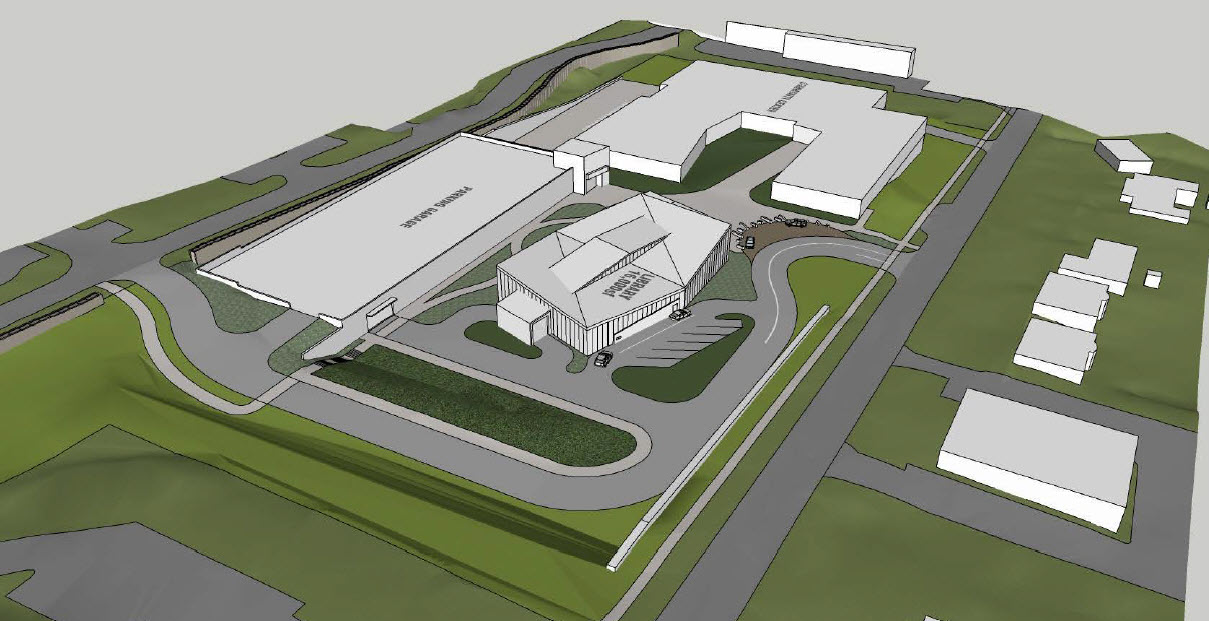
Slide presented on June 6, 2018 showing the "Geode" concept featuring an entry courtyard had made it all the way deeply into the building design, resulting in a site plan.
Another slide showing the proposed site plan that continued refining the "Geode" concept was also included in the presentation. The slide shows a well developed Building Information Model (BIM) showing that the entry courtyard "Geode" had made it all the way deeply into the building design by June 6, 2018 with no previous feedback except from the internal staff design team.
All these steps of the design process were condensed into a few minutes of presentation slides to the Community Center Design Committee.
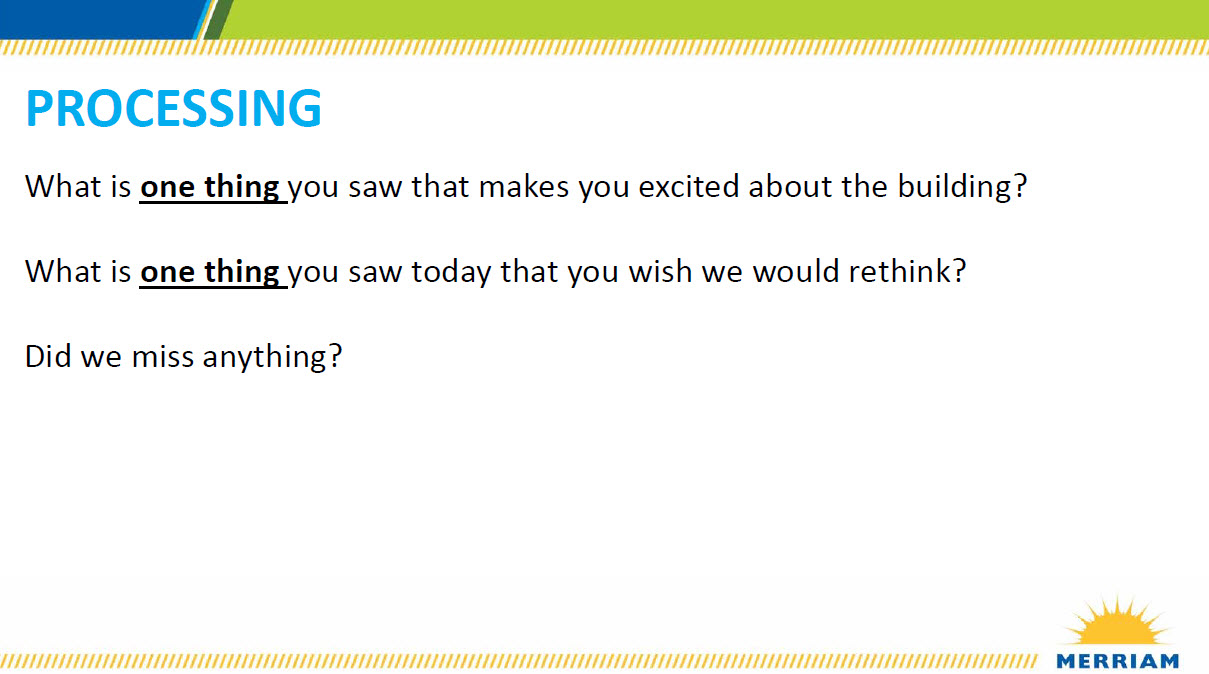
Slide presented on June 6, 2018 soliciting 'feedback' on all the steps of design that the staff internal team had decided over the previous 4-5 months.
"What is one thing you saw that makes you excited about the building?"
"What is one thing you saw today that you wish we would rethink?"
"Did we miss anything?"
"One thing"? This was never intended to be a serious feedback mechanism. Multiple design decision steps over many weeks were shown to the Design Committee for superficial rubber stamp approval to check off the process box that the Design Committee had been consulted at all. Where I come from in the industry, this exercise is called a "Dog and Pony Show."
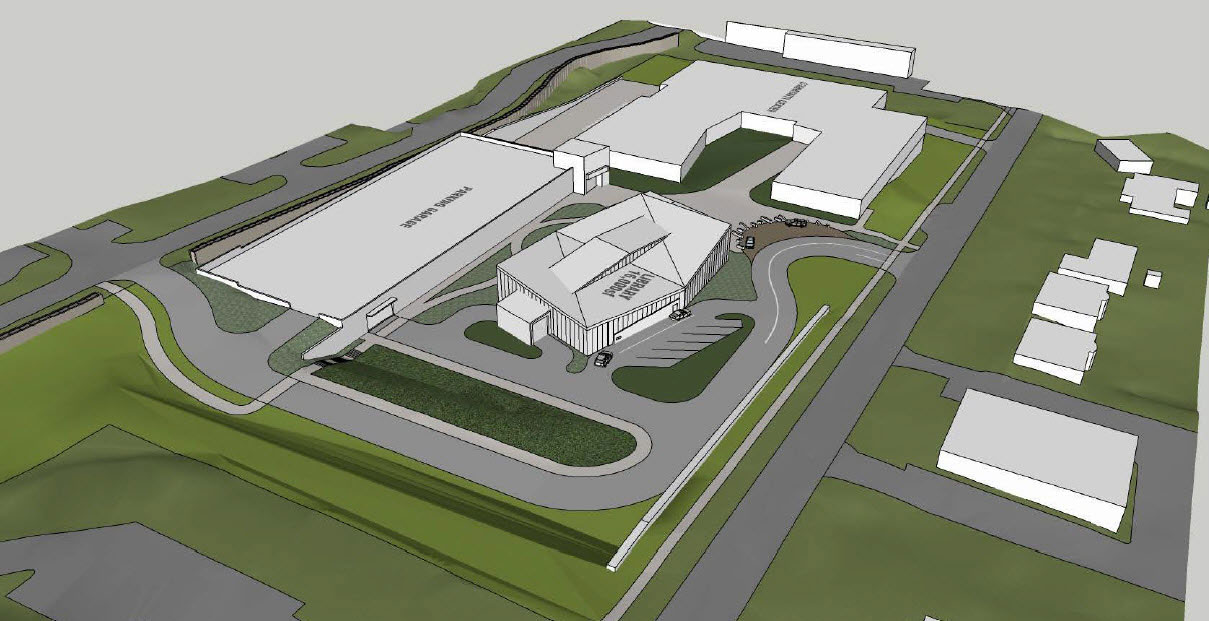
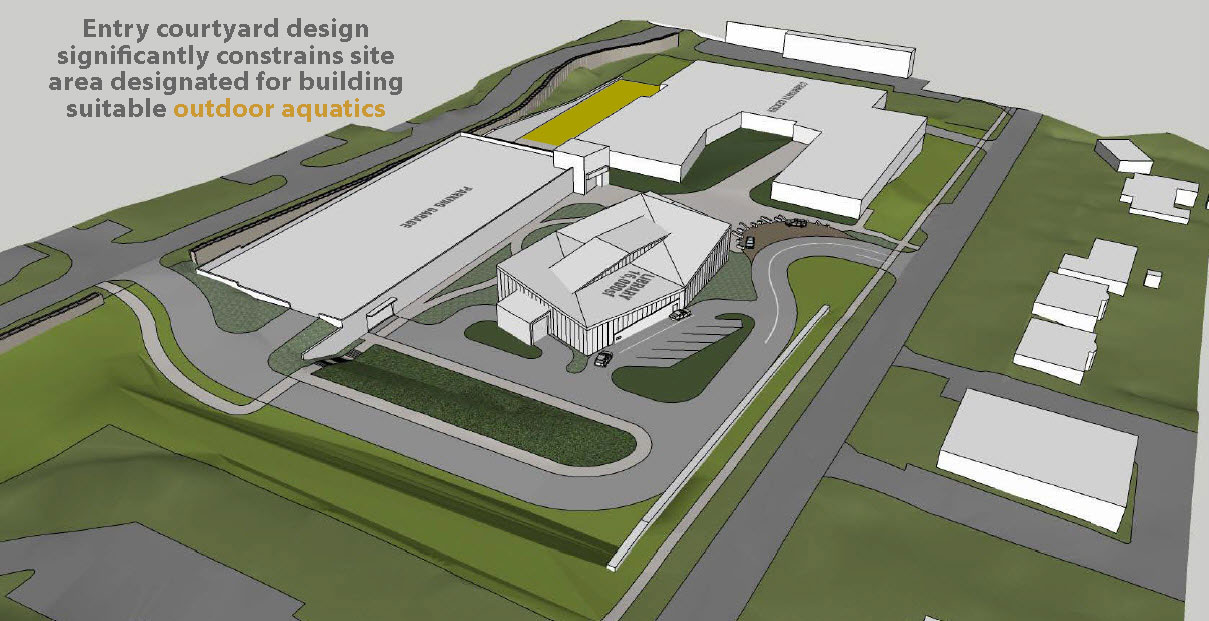
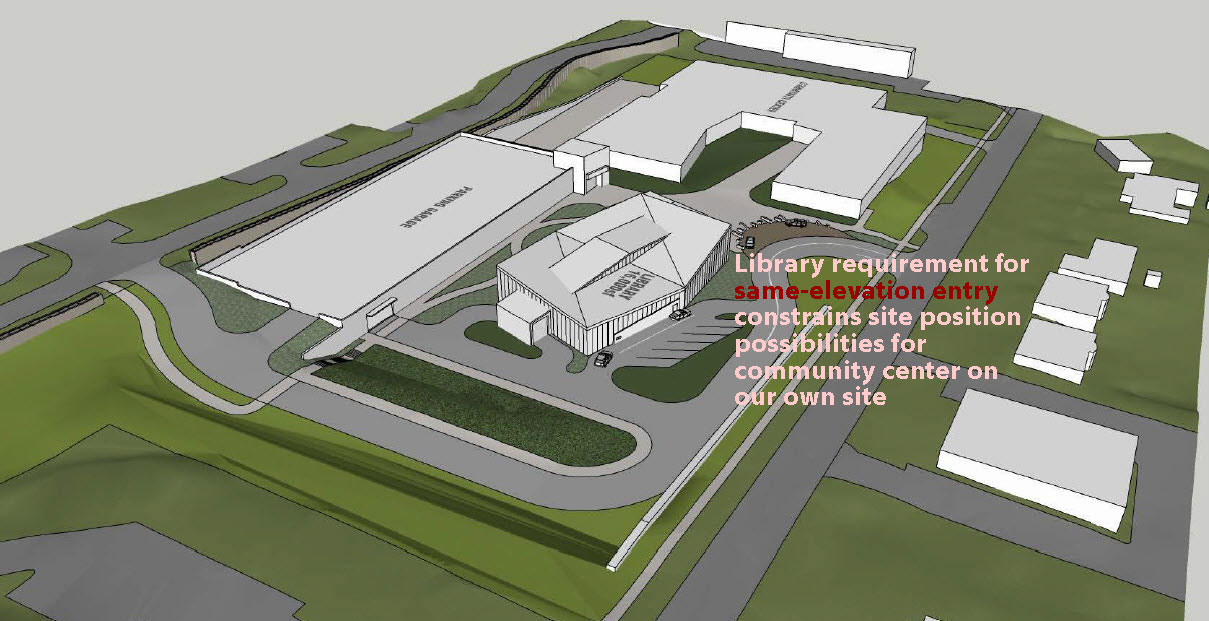
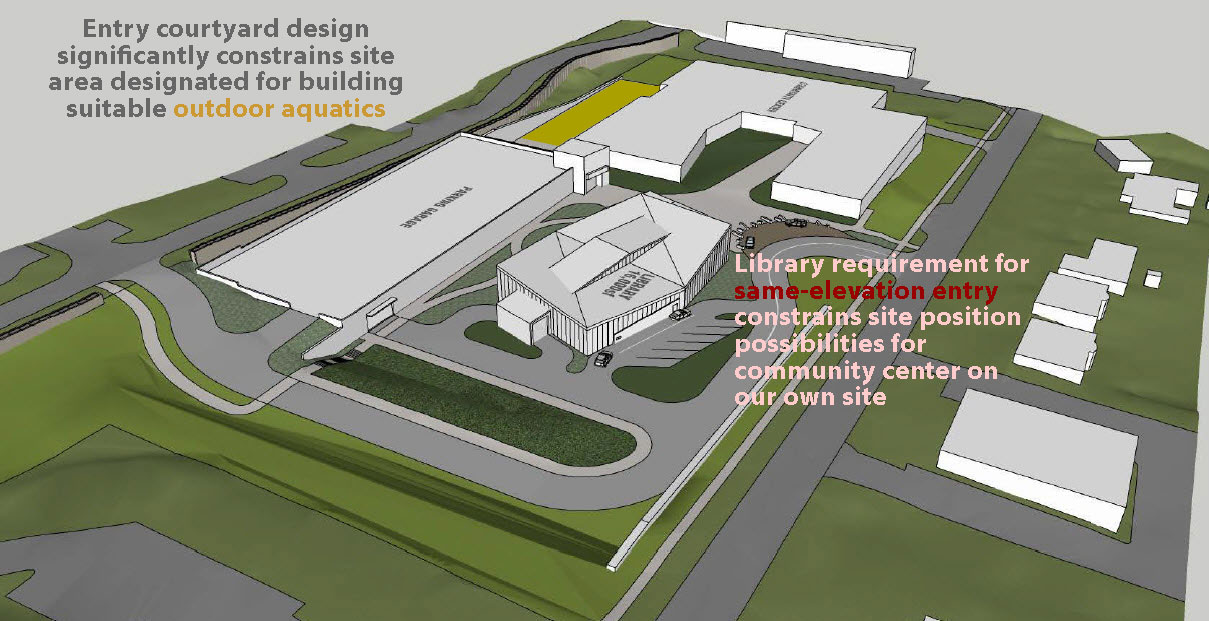
Advanced stage of building design had already been decided by staff before the Community Center Design Committee ever saw anything. Image from Design Committee presentation at first meeting on June 6, 2017. At this point, it was too late to materially question the main design decisions that had already been made by staff.
To see larger copies of each slide click the following links: Slide 1, Slide 2, Slide 3, Slide 4
(Credit ‐ graphics by D. Neal)
At this point in the design schedule it was probably too late to point out that the "geode" cut out design would make the building more costly to build and to operate, even if the Design Committee had included members that understood construction well enough to recognize this increased cost attribute of the design. Building cutouts create more exterior perimeter for the same square footage of building area. More exterior perimiter length equals more exterior cladding and windows which are expensive. Increased heating and cooling costs are typically associated with more glass on the exterior of a building.
Someone might have also noticed that the design widened the building footprint east-to-west, crowding out site space to be used for outdoor aquatics.
The outdoor aquatics design debacle
I woke up normally on July 9, 2018. There was nothing unusual about the day.
That changed at 5:30 PM when I first saw the outdoor aquatics design recommended by city staff. According to staff, the maximum size of outdoor pool facility that could be provided within the $30 million project budget was a 75 ft (25 yard) by 48 ft (six lane) main pool with an integrated dive well taking up about half of the pool.
A zero-depth entry fan feature about half the size of the existing zero-depth entry kids' pool at the Merriam Aquatic Center was also included.
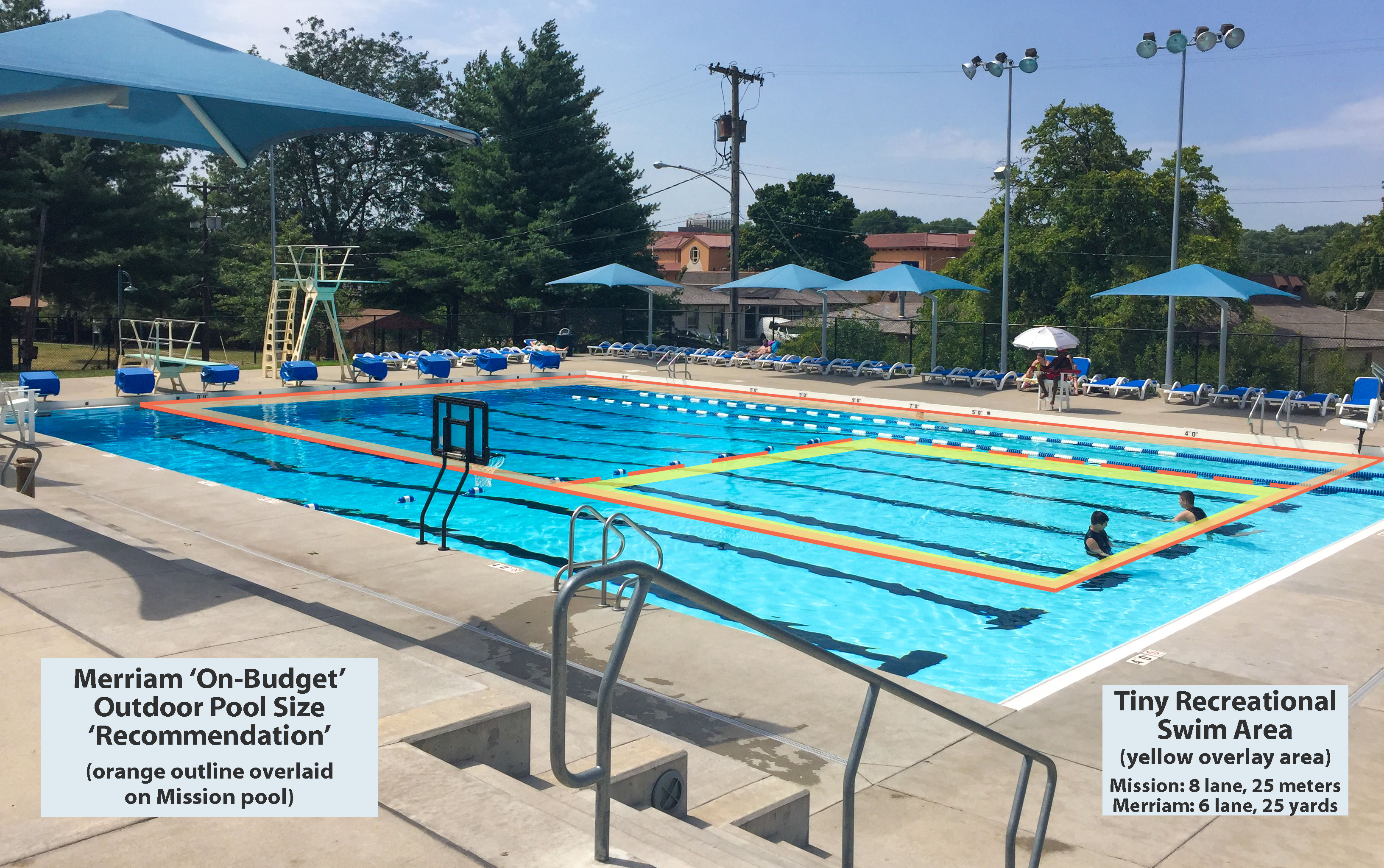
Comparison of the 'on-budget' staff recommendation for the new outdoor Merriam Community Center pool with the Mission pool. Note the recreational use area outlined in yellow.
When I first saw what appears to be a ridiculously poor outdoor aquatics design on July 9, I immediately began asking questions.
More troubling than the design itself has been the difficulty I have had in getting answers from staff about the process and getting supporting data underlying the design decisions made by staff.
After two weeks of receiving only partial answers, incorrect information, and push back to the very fact that I (as an elected official) was even questioning the staff 'team of professionals' judgment, I significantly ramped up my research. I began to check everything I could independently.
The more I looked, the more I found that was seriously troubling.
An email disclosure on July 20th by the Assistant City Administrator first alerted me that the entire (both indoor and outdoor) aquatics budget contained in the 2017 Facilities Master Plan had been folded into "a bucket" that was essentially the funds in the Master Plan's budget for outdoor aquatics. This email response had been sent in response to my request for a project budget breakdown by sub area/sub category that reflected the current design for indoor aquatics, outdoor aquatics and other aspects of the building.
I began to seek answers from other members of city staff who were not part of the internal 'design team.' Again what I found was even more troubling. In response to my direct questions to them, I was given documents in some cases that directly contradicted specific answers provided to me by senior staff.
In order to try and understand the different messaging I was receiving from city staff and the conflicting documentary information I had received, I asked different members of staff specific questions sometimes publicly and sometimes privately, already knowing the correct answer. When I received an incorrect answer, I made sure to ask again, re-wording it so there could be no mistaking what I was asking. Members of senior staff failed these credibility tests.
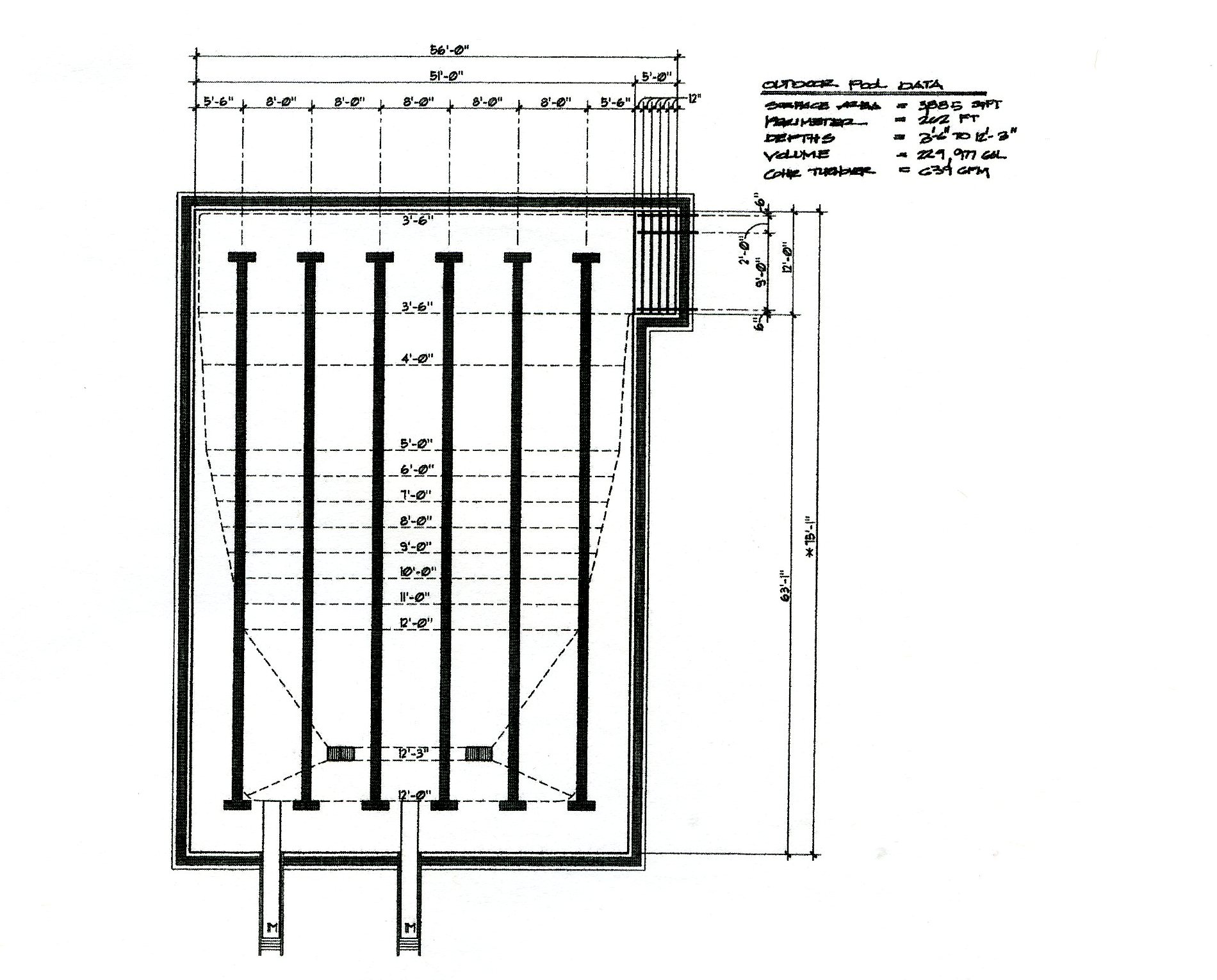
Outdoor pool design circulating among senior city staff in March 2018 showing minimal outdoor aquatics 'amenities.' This single outdoor option was accompanied by three options for the indoor aquatics. Someone in city staff must have directed the professional design consultants on the general size criteria to use when preparing these early designs. (Click to enlarge, view in new tab)
An outdoor pool design circulating among senior city staff in mid-March 2018 featuring a design for a minimalist outdoor aquatics offering to the residents of Merriam. This tiny pool design was not a mistake. This design was the direction that must have already been decided by senior city staff.
The two tiny 6-lane, 25-yard outdoor pool design options only differed in the size of the entry stairs. The two outdoor "options" were accompanied by three materially different options for the indoor aquatics. Someone in city staff must have directed the professional design consultants on the general size criteria to use when preparing this early design for the outdoor pool.
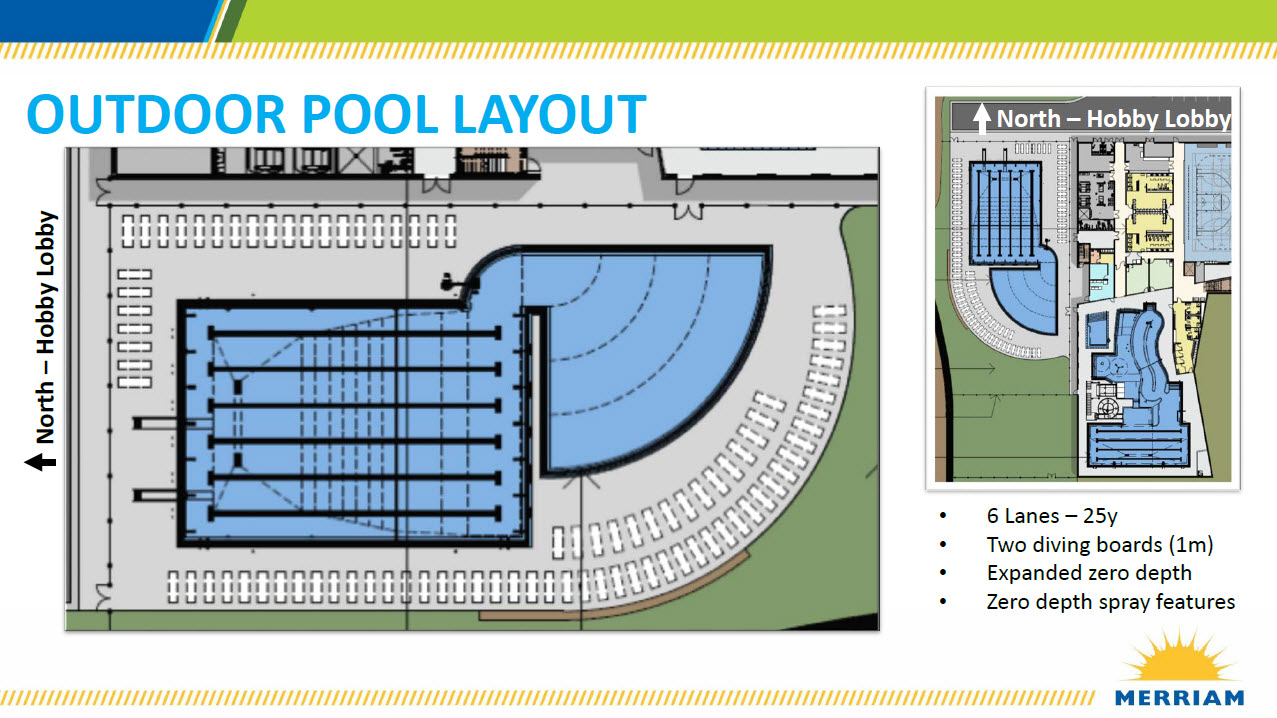
PowerPoint slide showing 'recommended' outdoor pool design as presented by staff to the Merriam City Council on July 9, 2018. (Click to enlarge, view in new tab)
In fact, the 6-lane, 25-yard outdoor pool design is exactly the same pool size that was 'recommended' to the Community Center Design Committee and then the City Council on July 9th when the 'aquatics design' was put forward for approval by the staff/McCarthy design 'team.'
Deception?
After vocally raising my concerns publicly at the City Council meetings on July 9, July 16 (Council Work Session), and July 23rd, during a 3-1/2 hour meeting on August 1st with one of the senior city staff members on the internal design 'team,' I expressed my pressing concern that the City Council should have been informed much sooner about the design decision to virtually eliminate the outdoor pool experience and lop off $5.6 million from the aquatics budget.
I asked whether there were plans for such an outdoor design in existence to look at "back in March and April." I was told, "No, we were still moving colored blocks around the site map at that point."
I asked again, "Are you sure there were no plans being considered at that time?"
"We didn't start drawing up actual plans until May" was the response.
What the staff member didn't realize was I already was in possession of the very plans that I was asking about.
I had asked about the plans only after receiving push back for my criticism of the process that kept the City Council in the dark for at least 4 critical months regarding the outdoor aquatics design direction that staff had apparently already decided to go with. I wanted to know who made the decision to gut the outdoor aquatics 'amenities' and when. I was told that 'staff' had informed us just as soon as they knew.
By the paper trail I had, clearly this was not true.
This is but one example of many misrepresentations, inaccuracies, exaggerations, and serious spin that has permeated this 'process' to build a new community center in Merriam. This communications modality seems to have been present for some time. There are more documents that contradict statements made by senior staff to City Council members. This lack of transparency and candor calls into question the very decision making processes of the City of Merriam.
I realize that my allegations are not going to win me many friends in city administration. Probably I am making some other members of the Council upset as well. On the other hand, I do not believe I was elected to make friends or "support the staff" blindly. I was elected to serve the interests of Merriam residents. When something seems to be amiss, I believe it is my duty to find what the truth actually is.
How can we make decisions as elected officials if we are being kept in the dark, provided less than accurate information, and are in some instances actually lied to in order to 'guide' the 'process' – which apparently includes managing the perceptions of members of the City Council – by some higher authority?
Having said this, I stand willing to work to fix the problems, both with the design and with the processes.
What I will continue to fight is the idea that anything less than fully accurate information is sufficient for decision making in the city of Merriam. Good people can have different opinions about the best way to solve a particular problem. However if the background information provided to the decision makers is tainted or manipulated, then the resulting decisions based on that information are not legitimate exercises in the democratic process.
As a result of this seriously flawed design 'process', the Merriam Community Center project now has the following troubling attributes:
- Outdoor aquatics deliverables have clearly been an afterthought for the staff design 'team,' both in terms of process and design importance.
- Merriam will have the smallest municipal main outdoor swimming pool in Johnson County.
- At a maximum water depth of 3'6" for the indoor aquatics (Master Plan calls for 5'), many uses of this "water" are limited.
- The indoor aquatics 'experience' will be very different from an outdoor summer pool experience and many residents will likely not accept one for the other.
- The project budget has increased 22% based on staff design and a decision to co-locate the Antioch Library on our site.
- The Master Plan has not been followed, even remotely with major design changes throughout the building and outside it.
- At least $5.6 million budget dollars were shifted out of aquatics to something else at least as early as March 2018 but not disclosed to the City Council.
- That 'something else' is still unknown despite repeated requests for project budget sub categories.
- No project construction budget subcategory breakdown was been provided since I asked for it on July 20, 2018.
- The aquatics design has only marginally been improved recently at an additional city investment of $1.6 million that already should have been available in the project budget.
- When asked specific critical questions during the aquatics design discussions within the City Council, I was repeatedly answered with deflection, misdirection, inaccurate and/or incomplete information by members of the senior city staff.
With $1.6 million more money added beyond the original community center project funds in order to improve aquatics closer to the requirements of the 2017 Facilities Master Plan, why will Merriam still end up with the smallest main outdoor swimming pool in Johnson County?
Based on these observations, I cannot see how there has been a competent design process undertaken, especially with respect to aquatics.

